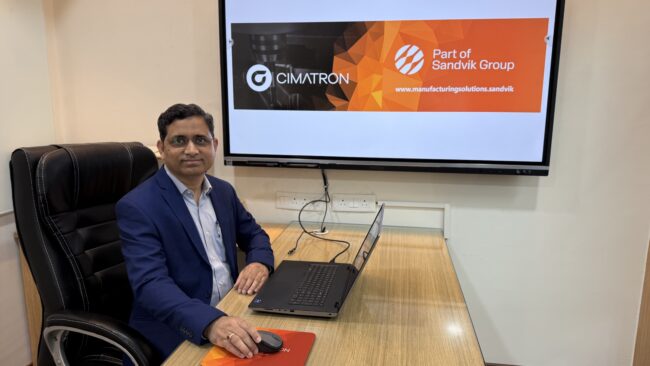“By capturing key parameters such as speed, feed, depth of cut, spindle load,
temperature, torque, and vibrations, manufacturers can monitor real-time performance
and make informed decisions to enhance tool life, reduce power consumption, and
improve surface finish, all while maintaining product quality and minimising cycle time,”
says Amol Mane, Director- Sales and Marketing, Cimatron (Southeast Asia, India, Middle East, ANZ and South Africa)

Q. As product designs become increasingly iterative and subject to frequent changes, how can integrated CAD/ CAM systems help ensure design efficiency, minimise errors during engineering change orders, and maintain workflow reliability from virtual modelling to actual manufacturing?
Ans- Traditionally, people used to have one CAD platform for design and a separate CAM platform for
manufacturing. So, whenever there was a revision in the product design, those changes were reflected in the mould or die design and then in manufacturing as well. While using two different platforms, it becomes a struggle, as one has to manually update the input model data for CAM programming when the mould/die design is revised as per the revised product design. These platforms aren’t integrated, which makes the workflow prone to errors and inefficiencies.
When CAD and CAM are interconnected in a single interface, the workflow from Concept to Reality (Design to Manufacturing) is seamless. A design change made through an Engineering Change Order
(ECO) is automatically reflected in CAM programming and hence, in the manufactured part. There is no
need to worry about missing updates corresponding to revisions in the product design, it is all synchronised. In contrast, many tool rooms using separate platforms must manually ensure that any design revisions are reflected in the mould and die, and then again in the CAM process. This manual approach is error-prone and can result in design mismatches.
Manufacturing often runs across multiple shifts, and any delay or gaps in communicating changes can result in producing parts based on obsolete designs. This could lead to rework or rejections, increasing the cost of poor quality. If the proper revision isn’t followed during manufacturing, the result can be customer dissatisfaction due to delays or defective output. It also impacts delivery timelines and time-to-market.
Q. How is Industry 4.0 transforming machining processes and decision-making in CAD/CAM environments? What role does data play in this shift?
Ans- Industry 4.0 is essentially the fourth industrial revolution, where we act smartly by sensing, processing, and responding to deviations in manufacturing processes. It revolves around collecting real-time data, analysing it, and making logical decisions based on those insights.
In a machining environment, data can be collected from various elements like the cutting tool, machine tool, tool holder, and workpiece covering parameters such as speed, feed, depth of cut, temperature, spindle torque, power consumption, and cutting load. This data helps optimise machining parameters to reduce power consumption, extend tool life, and maintain surface quality, all while ensuring optimal cycle time.
Moreover, this data-driven approach aids in better machine utilisation, predictive maintenance planning, and improved Overall Equipment Effectiveness (OEE). Sensors play a key role here by monitoring factors like spindle load, temperature, and vibration; we can schedule preventive maintenance and avoid unplanned downtimes. In essence, Industry 4.0 enables smarter, more efficient, and highly informed manufacturing decisions in CAD/CAM environments.
Q. What are the implications of retiring skilled workers on knowledge transfer? How is technology helping bridge the gap?
Ans- Today, many knowledgeable programmers and operators with 20-25 years of hands-on professional manufacturing experience are retiring. The challenge for the industry is how to effectively capture and transfer that invaluable knowledge to the next generation, especially when much of the workforce now includes contract workforce that changes every six months.
Technology is playing a vital role here. With the help of Industry 4.0 tools, we can now document and digitise that expertise, enabling faster training and knowledge sharing. This ensures that regardless of the operator’s experience level, the process delivers consistent output in terms of product quality and cost.
Ultimately, it’s about bringing consistency, optimising processes, and ensuring maximum utilisation of assets like machine tools and cutting tools, even in the face of a rapidly changing workforce.
Q. How are data-driven technologies transforming the way machine tool manufacturers optimise machining processes, tool performance, and shop floor efficiency?
Ans- In the machine tool industry, data-driven technologies are revolutionising how machining operations are optimised. By capturing key parameters such as speed, feed, depth of cut, spindle load, temperature, torque, and vibrations, manufacturers can monitor real-time performance and make informed decisions to enhance tool life, reduce power consumption, and improve surface finish, all while maintaining product quality and minimising cycle time.
As machines generate a huge amount of data, this information can be used not only to optimise cutting conditions but also to predict maintenance needs, thereby extending equipment life and improving Overall Equipment Effectiveness (OEE). Traditionally, such process decisions relied heavily on experienced operators. However, with the aging workforce and rising use of contract labour, retaining and transferring manufacturing domain knowledge has become a challenge.
Now, machine learning and intelligent systems enable machines to learn from past machining patterns such as material type, tooling used and achieved results, shifting the reliance from human expertise to system-driven intelligence. This evolution supports consistent output regardless of operator skill and positions machine tool manufacturers at the forefront of smarter, more autonomous production environments.
(The interview was first published in TAGMA Times May 2025 edition)




COMMENTS